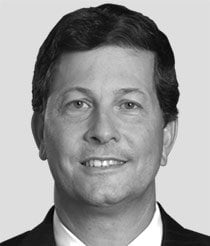We're living in the proverbial interesting times.
As a technical trader, it's intriguing to me that all the headline-generating volatility - and U.S. Federal Reserve inaction - we've seen lately really hasn't made the market nosedive or skyrocket for any significant length of time.
And so investors, who need to know what's coming next, are looking in some strange places to find the answer.
For instance, plenty of technical traders and analysts spend time on "chart analogues," digging up charts from the Crash of 1929 and overlaying today's price activity to generate a plan of action.
I don't think that's very useful - because it's not 1929 we should be looking at...
Rather, it's much more recent history that's telling me what to expect from the rest of 2015 through the New Year.
I've got the answer right here...
The Only Pattern That Counts Right Now
 Some analysts are looking back to early October 2014 at the 9.9% peak-to-trough market drop. At the time, the losses wiped out most of 2014's gains, and pundits were calling for a "big reckoning."
Some analysts are looking back to early October 2014 at the 9.9% peak-to-trough market drop. At the time, the losses wiped out most of 2014's gains, and pundits were calling for a "big reckoning."
But then of course we saw a classic "V bottom" that sent the markets rallying back all the way through December 2014.
I believe we should look back to the price activity of Aug. 6, 2011, to get a feel for where we are now.
At that time, Standard & Poor's downgraded the U.S. credit rating from the AAA it had boasted since 1941 to AA+, leaving open the possibility of a further downgrade.
At the same time, the contagion caused by the European sovereign debt crisis appeared to be spreading.
Global markets swooned, losing around $2.5 trillion in equity value. The major American indexes bled out: The Dow Jones crashed 5.6%, the S&P 500 lost 6.7%, and the Nasdaq shed 6.9%.
The markets did then what they're doing now...
They came off the bottom and traded sideways for several weeks until dropping again through October 2011. The markets tested lows and then soared back from there.
I'm convinced we're in a similar pattern, both technically and fundamentally. And I think we'll see the markets test new lows again shortly.
But on a technical level, the markets are oversold. When that "rubber band" gets stretched too far to the downside, it will tend to correct and snap back up.
There's another reason I'm predicting some recovery this year: I expect some "earnings help."
Here's what I mean...
How Earnings Fit into the Picture
Let's face it: The last quarter's earnings were bad, a disappointment in almost every respect. In fact, it was the first down quarter in a long time, even if it did end up a little better than the analysts were actually expecting.
But here's where analysts can help us out as they build their earnings-per-share estimates and aggregate numbers for the S&P 500.
I believe they'll find the third quarter of 2015 to be much better than the second, and I see that conviction firming up in the markets, too. That improved earnings picture will lend some real momentum to trading into the end of the year.
But... don't expect the recovery to last too long into 2016.
This Will Bring Downward Pressure Back
As I said, the market is always trying to guess what happens next, and when it can't do that, as has been the case with China and the Fed, volatility bubbles up.
Some pundits are beginning to doubt that the Fed will hike rates this year. They're pointing to the October meeting, which isn't traditionally accompanied by a press conference, and saying Fed Chairwoman Janet Yellen won't raise rates without the chance to explain her decision.
[mmpazkzone name="in-story" network="9794" site="307044" id="137008" type="4"]
And I've heard people talking emotionally about the Fed not moving to raise rates in December, either, thinking perhaps the Fed won't ruin the holidays with a rate hike.
But of course the Fed doesn't think that way. It will raise rates, and there's only one remaining chance to do it this year if the central bank wants to retain any credibility. The Fed simply can't back down.
When rates do move, we can expect that volatility to return.
China, too, will play a part in the downward pressure I see shaping up in the New Year. The country is such a huge consumer of commodities and raw materials that, if their economy continues to slow down, it will drive the markets lower.
So a continued slowdown in China and a move from the Fed will be the one-two punch that sends the markets back down. That's what to watch for.
Fortunately, there's an easy way to know when it's safe to put your money back to work again.
The Market Needs to Crack These Levels to Come Back
This summer, I saw the "participation" of stocks dropping; we were hovering around new highs, but fewer stocks were coming along for the ride. That was what told me to start preparing my next move.
So I got around 50% of the capital I control back onto the sidelines and dodged a falling knife. That's a reliable strategy for whenever the markets seem poised for a downturn.
I don't really want to put a lot of new money to work right now - until I see a specific break for the upside, like this.
The market has to challenge and break some of the classic upside resistance levels, like 2,000 on the S&P 500 cash chart. Now, the markets tried for that back on Thursday after the Fed's (non)announcement... but they fell right back down.
When they can manage to stay above it, it will be safe to bring money back in.
Until we can crack that, until we can beat the 50-period moving average and then challenge the 200-period moving average, "caution" is the byword.
Join the conversation! Follow D.R. on Facebook and Twitter.
About the Author
D.R. Barton, Jr., Technical Trading Specialist for Money Map Press, is a world-renowned authority on technical trading with 25 years of experience. He spent the first part of his career as a chemical engineer with DuPont. During this time, he researched and developed the trading secrets that led to his first successful research service. Thanks to the wealth he was able to create for himself and his followers, D.R. retired early to pursue his passion for investing and showing fellow investors how to build toward financial freedom.



